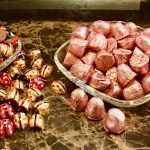Antigua, Guatemala, is a stunningly beautiful colonial town with cobbled streets, glorious cathedrals and colorful markets filled with exquisite Mayan textiles. In 2008, I was lucky enough to spend a number of days in Antigua during Lent.

It must be quite an honor to take the center position at the head of the float. That man or woman carries the float with their arms spread wide in a position reminiscent of a crucifixion. ©Laurel Kallenbach
On Sundays throughout Lent, there are 10-hour processions up and down the streets of Antigua. They usually start at 1:00 in the afternoon and last until 11:00 at night.

This small float is probably Mary Magdalene. The sousaphone behind her is another band of musicians. ©Laurel Kallenbach
Hundreds of participants dress in regal robes and carry gigantic floats (andas) as onlookers watch. The floats are filled with sculptures of Jesus dragging the cross, the Virgin Mary looking beatific, and scores of angels playing herald trumpets.
Antigua has one of the most elaborate Holy Week (Semana Santa) celebrations in the Americas, and the city’s hotels are filled to bursting throughout the week.
For Semana Santa, carpets of sawdust paintings fill the streets as the processions walk through; that doesn’t happen on Lenten Sundays, but would be quite a sight. (A small sample of a sawdust carpet was preserved in the cathedral, and it was amazingly intricate and colorful.)

Mary, the Queen of Heaven looks mournfully down upon the spectators while women shoulder the burden of her holiness. ©Laurel Kallenbach
Some of the floats weight as much as 3 tons, so it takes quite a few people to bear them on their shoulders. The float-bearers take shifts to spell each other, but they all keep shuffling slowly through the streets to the dirges played by marching musicians.
I watched the procession four times along various streets. Because the parade moves so slowly, it was easy to watch it pass, then walk six or eight blocks around the route, and catch the whole pageant somewhere else.
The final time I saw the procession pass by was from the window of a restaurant at about 8 p.m. In the dark, the floats were lit and had a different aura than they did by day. Night or day, the procession is quite a spectacle.

Many of the celebrants were boys in their early teens, all wearing robes?either purple (the color of the Passion) or white like shepherds. Some wore pointed hoods that remind Americans of the Ku Klux Klan. ©Laurel Kallenbach
The parade begins with blocks of processing boys and men in robes, hoods and cassocks. That’s followed by altar boys swinging the incense burners. The streets of Antigua fill with the smoky aroma, turning the entire city into a cathedral-like setting.
Then comes the massive float with Jesus carrying the cross over his shoulder. This is followed by musicians.
Next, the Virgin Mary float arrives, borne by women in somber gray and black dresses with lace on their heads. Although the Virgin Mary float is smaller, it’s impressive to see women in heels and skirts carrying what is still a massive burden.
All the locals take these processions very seriously—even mournfully. Bystanders in their jeans and flip-flops (or Mayan clothes if they’re visiting from a small village) gaze meaningfully at the floats. The participants are all very proud and solemn about their jobs.
However, there’s also an air of festivity: hawkers sell cotton candy, toys and sodas. As you’re in the large crowds, you’re shoulder-to-shoulder with other bystanders on the sidewalks trying to glimpse the floats and take photos.
Pickpockets make a healthy living on procession days. Although I felt nothing, for some reason I looked down at my fannypack and noticed the zipper was open—not the way I left it. I checked, and the only thing missed was the granola bar that I had tucked in at the last moment on top.
A friend of mine was not so fortunate. Her wallet disappeared from her purse, but fortunately her passport was safely back in the hotel safe.
Watching the processions made me truly feel like I had sampled a bit of the local culture of Guatemala, a fervently Catholic—and Mayan—country.

Women wearing heels carry the Virgin Mary float through Antigua’s bumpy, cobblestone streets. ©Laurel Kallenbach
—Laurel Kallenbach, writer and editor
Read more about my travels in Guatemala:
Originally published in April 2009



